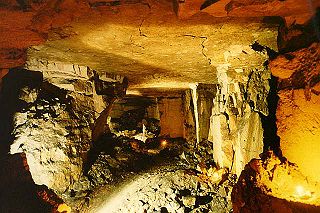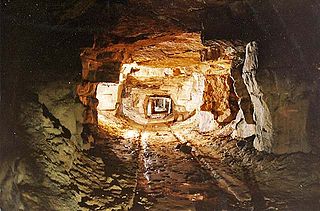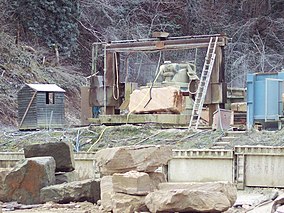
The greater horseshoe bat is an insectivorous bat of the genus Rhinolophus. Its distribution covers Europe, Northern Africa, Central Asia and Eastern Asia. It is the largest of the horseshoe bats in Europe and is thus easily distinguished from other species. The species is sedentary, typically travelling up to 30 kilometres (19 mi) between the winter and summer roosts, with the longest recorded movement being 180 km (110 mi). The frequencies used by this bat species for echolocation lie between 69–83 kHz, have most energy at 81 kHz and have an average duration of 37.4 ms.

Brown's Folly or Brown's Folly is a folly tower sitting within a 39.9 hectare biological and geological Site of Special Scientific Interest (SSSI) near the village of Bathford in Somerset, notified in 1974: the site itself is known as the Farleigh Down Stone Quarry, and is managed as a nature reserve by the Avon Wildlife Trust (AWT). The tower was built in 1848 and is a Grade II listed building.

Combe Down and Bathampton Down Quarries make up a 6.22 hectare Site of Special Scientific Interest (SSSI) in Bath and North East Somerset, England, important for its bat population. The disused quarries date from the 17th and 18th centuries and were the source of Bath stone for the city of Bath and elsewhere in the UK. A five-year project to stabilise the quarry workings was largely completed by November 2009.
Littledean Hall is a country house in the village of Littledean, Gloucestershire, England. It has been described as one of the most haunted houses in England and is thought to be the oldest house in the United Kingdom which is still occupied. Saxon and Celtic remains have been uncovered in the cellars. Part of the house is designated an SSSI as it is a proven breeding roost for the Greater Horseshoe Bat (Rhinolophus ferrumequinum).
Fonthill Grottoes is a 0.69 hectare biological Site of Special Scientific Interest, in woodland adjacent to Fonthill Lake in Wiltshire, notified in 1994. Its SSSI designation is due to its roosting bats: the site is the sixth largest hibernaculum in Britain.

Box Mine is a 56.6 ha biological Site of Special Scientific Interest, near the village of Box in Wiltshire, England, notified in 1991.
Winsley Mines is a 1.48 hectare biological Site of Special Scientific Interest, near the village of Winsley in Wiltshire, England, notified in 1989.

Sylvan House Barn is a 0.005-hectare (0.012-acre) stone built barn near the village of St Briavels, in the Forest of Dean, Gloucestershire. Because of its breeding bats, the site was notified as a biological Site of Special Scientific Interest in 1995.

Chilmark is a Wiltshire village and civil parish of some 150 houses straddling the B3089 road, 11 miles (18 km) west of Salisbury, England. The parish includes the hamlets of Mooray and Portash, both close to the south of Chilmark village; and the dispersed hamlet of Ridge, to the southwest.

Beer Quarry Caves is a man-made limestone underground complex located about a mile west of the village of Beer, Devon, and the main source in England for beer stone. The tunnels resulted from 2,000 years of quarrying beer stone, which was particularly favoured for cathedral and church features such as door and window surrounds because of its colour and workability for carving. Stone from the quarry was used in the construction of several of southern England's ancient cathedrals and a number of other important buildings as well as for many town and village churches, and for some buildings in the United States. Extraction was particularly intense during the Middle Ages, but continued until the 1920s. An adit to another set of workings can be seen from the South West Coast Path east of Branscombe, having been exposed by a landslip in the late 18th century. The quarry is part of the Jurassic Coast, and is a Site of Special Scientific Interest (SSSI).
Chicksgrove Quarry is a 14 acres (5.7 ha) geological Site of Special Scientific Interest south of Upper Chicksgrove in Wiltshire, England notified in 1971.

Blaisdon Hall is a Grade II* listed building at Blaisdon. It includes a 0.07-hectare (0.17-acre) biological Site of Special Scientific Interest in Gloucestershire, notified in 1995.
Buckshaft Mine & Bradley Hill Railway Tunnel is a 5.66-hectare (14.0-acre) biological Site of Special Scientific Interest in Gloucestershire, notified in 1998. This site comprises two separate locations. One is Buckshaft Mine which is near the village of Ruspidge. The other location is Bradley Hill Railway Tunnel which is near the village of Soudley.

Caerwood And Ashberry Goose House is a 0.01-hectare (0.025-acre) biological Site of Special Scientific Interest in Gloucestershire, England, notified in 1991. The site was previously notified as Caerwood, Tidenham and lies within the Wye Valley Area of Outstanding Natural Beauty.

Devil's Chapel Scowles is a 44.79-hectare (110.7-acre) biological Site of Special Scientific Interest in Gloucestershire, notified England, in 1998. The site lies in the Forest of Dean and has four units of assessment by Natural England.

Old Bow And Old Ham Mines is a 40.3-hectare (100-acre) biological Site of Special Scientific Interest in Gloucestershire, notified in 1998.

Westbury Brook Ironstone Mine is a 15.69-hectare (38.8-acre) biological Site of Special Scientific Interest in Gloucestershire, notified in 1998.

Wigpool Ironstone Mine is a 34.88-hectare (86.2-acre) biological Site of Special Scientific Interest in Gloucestershire, notified in 1998.

The Bath and Bradford-on-Avon Bats SAC is a Special Area of Conservation originally designated under the European Union's Habitats Directive (92/43/EEC), also known as the Directive on the Conservation of Natural Habitats and of Wild Fauna and Flora.









